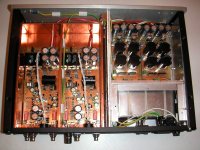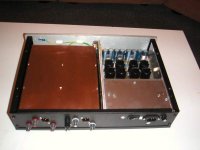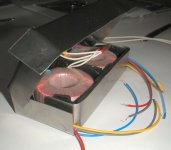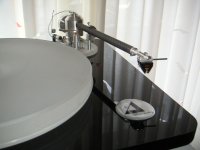Hi group,
I want to share my latest project; pimping my Pass Aleph ONO.
After finishing my Aleph 5, I wanted to upgrade my phono pre-amp. Because of the fantastic sonic results of the Aleph 5, I wanted to choose between Pearl and the Pass ONO. Because I use a MC element, I chose to go with an Aleph ONO.
I was not able to buy the PCB’s, but was able to get fully populated boards. Making my own boards will of course be the next step!
I just finished my first PCB’s, soft start for my Aleph 5 and did not think I was up to designing the ONO PCB’s from scratch, so I started looking for some PCB’s. I was not able to buy the PCB’s, but was able to get fully populated boards. Making my own boards will of course be the next step!
Ending up with populated boards gave me time to optimize the other parts; cabling and casing. I started out with the PCB’s and the trafo’s mounted on a wooden board, and started out from there. Physical restrictions and WAF factor prevented me from using the more normal 2 case solution, so I had to look for another solution. The solution was using three boxes inside a standard casing, and especially the use of mumetal.
The amplifier boards are located inside a box of copper, all 6 mm except the front and the back. I left these 3 mm because of finances, and because I thought with all the holes in these boards 6 mm would be overdone.
The power supply was first done with 8mm thick walls, using two aluminium plates and a copper plate sandwiched between. I found out that 50 Hz wave forms were still coming through, that is why I also used a mumetal box around the transformers.
After that I also introduced a mumetal sheet between the amplifier part and the power supply. Not that I could still measure 50 Hz waveforms, but I was unsure that my method of measuring (coil for measuring magnetic fields, and a oscilloscope to see the field) was exact enough.
All in all I ended up with a 20,5KG heavy box. When you look at the specs from the real XONO you see that the combination of two boxes is also around this weight!
I want to share my latest project; pimping my Pass Aleph ONO.
After finishing my Aleph 5, I wanted to upgrade my phono pre-amp. Because of the fantastic sonic results of the Aleph 5, I wanted to choose between Pearl and the Pass ONO. Because I use a MC element, I chose to go with an Aleph ONO.
I was not able to buy the PCB’s, but was able to get fully populated boards. Making my own boards will of course be the next step!
I just finished my first PCB’s, soft start for my Aleph 5 and did not think I was up to designing the ONO PCB’s from scratch, so I started looking for some PCB’s. I was not able to buy the PCB’s, but was able to get fully populated boards. Making my own boards will of course be the next step!
Ending up with populated boards gave me time to optimize the other parts; cabling and casing. I started out with the PCB’s and the trafo’s mounted on a wooden board, and started out from there. Physical restrictions and WAF factor prevented me from using the more normal 2 case solution, so I had to look for another solution. The solution was using three boxes inside a standard casing, and especially the use of mumetal.
The amplifier boards are located inside a box of copper, all 6 mm except the front and the back. I left these 3 mm because of finances, and because I thought with all the holes in these boards 6 mm would be overdone.
The power supply was first done with 8mm thick walls, using two aluminium plates and a copper plate sandwiched between. I found out that 50 Hz wave forms were still coming through, that is why I also used a mumetal box around the transformers.
After that I also introduced a mumetal sheet between the amplifier part and the power supply. Not that I could still measure 50 Hz waveforms, but I was unsure that my method of measuring (coil for measuring magnetic fields, and a oscilloscope to see the field) was exact enough.
All in all I ended up with a 20,5KG heavy box. When you look at the specs from the real XONO you see that the combination of two boxes is also around this weight!
Attachments
This is a picture from the inside, with the separate boxes closed.
After I finished the phono pre, I took it with me to when I got the oil changed in my turntable, I was able to compare it with a Jadis DPMC tube phono pre on a very expensive installation with Metronome Technologie equipment. I am very happy to report that the ONO was much more fluent, and a much better stage.
Good work Mr. Pass!!
After I finished the phono pre, I took it with me to when I got the oil changed in my turntable, I was able to compare it with a Jadis DPMC tube phono pre on a very expensive installation with Metronome Technologie equipment. I am very happy to report that the ONO was much more fluent, and a much better stage.
Good work Mr. Pass!!
Attachments
Pointers for use with mumetal
I found out that mumetal works great, but needs a lot of space. Mumetal saturates when mounted too close to the transformer. Further more two smaller transformers are easier to shield than one large transformer.
Mumetal changes the form of the field. What I measured is that mumetal does not completely contain the field, but also generates a field close around the mumetal. This means you get the best results as you magnetically isolate the mumetal from the box you put it in. Professionals use layers of mumetal with RVS holders between. I used bitumen to isolate the transformer inside the mumetal, and to isolate the mumetal box from the aluminium box.
Mumetal does not work anymore when you make the folds too sharp! I simply made a wooden box with rounded corners, and used a piece of wood and a hammer to fit the mumetal around. Then I opened up the box again and exchanged the wood for the trafo’s which I mounted in the middle of the box, isolated from the mumetal with bitumen.
One other item: The mumetal does not give through warmth as good as aluminium!
Greetings, Harry
I found out that mumetal works great, but needs a lot of space. Mumetal saturates when mounted too close to the transformer. Further more two smaller transformers are easier to shield than one large transformer.
Mumetal changes the form of the field. What I measured is that mumetal does not completely contain the field, but also generates a field close around the mumetal. This means you get the best results as you magnetically isolate the mumetal from the box you put it in. Professionals use layers of mumetal with RVS holders between. I used bitumen to isolate the transformer inside the mumetal, and to isolate the mumetal box from the aluminium box.
Mumetal does not work anymore when you make the folds too sharp! I simply made a wooden box with rounded corners, and used a piece of wood and a hammer to fit the mumetal around. Then I opened up the box again and exchanged the wood for the trafo’s which I mounted in the middle of the box, isolated from the mumetal with bitumen.
One other item: The mumetal does not give through warmth as good as aluminium!
Greetings, Harry
Attachments
Good work, Harry!! We have to digest your writings, to make further commentsGood work Mr. Pass!!
Steen
Hi Steen,
Absolutely no buzz, hiss, humm or anything. Just music

I chose the Aleph over the Pearl because my cartridge has only 0.24 mV signal. Mr. Pass tells in his Pearl article that the pearl wass a slightly more noisier, and a little less gain. He tested with cartridges that have twice the output of mine.
(And of course the ONO looks sleeker, and has a blue LED)
Greetings, Harry
Absolutely no buzz, hiss, humm or anything. Just music
I chose the Aleph over the Pearl because my cartridge has only 0.24 mV signal. Mr. Pass tells in his Pearl article that the pearl wass a slightly more noisier, and a little less gain. He tested with cartridges that have twice the output of mine.
(And of course the ONO looks sleeker, and has a blue LED)
Greetings, Harry
Thats just great, Harry! I made several phonostages and they all suffered from some noiseAbsolutely no buzz, hiss, humm or anything. Just music

Steen
Hi Steen,
I am using a Zyx RS30, which is a great combination with my unipivot arm from ClearAudience.
I tried the Grado series too, but the Zyx was much better in handling old scratched records. That makes the great combination with the ONO. I have a lot of people coming by now, with both a new Aleph 5 and Pass ONO, because real Class A systems are still rare in Holland. Most people cannot believe the "silences" the system can produce. They keep checking, because they expect small hisses, ticking etc.
Greetings, Harry
I am using a Zyx RS30, which is a great combination with my unipivot arm from ClearAudience.
I tried the Grado series too, but the Zyx was much better in handling old scratched records. That makes the great combination with the ONO. I have a lot of people coming by now, with both a new Aleph 5 and Pass ONO, because real Class A systems are still rare in Holland. Most people cannot believe the "silences" the system can produce. They keep checking, because they expect small hisses, ticking etc.

Greetings, Harry
Attachments
Banned
Joined 2002
Hi jleaman,
I guess you know how it sounds; incredible!
All the copper does help. I first started out with all the electronics close together on a wooden board. It was good then, but with the casing complete the stage got better, low got more detailed etc. etc.
The incredible silence is the result of the difficult casing surrounding the power supply. The stage got better with the copper shielding.
I always wondered why the Pass XONO is so incredibly expensive in Europe. Well, now I know. Even if Nelson Pass would feel sorry for us poor guys, and decides to sell them for cost they would still be very expensive. There is a lot of money going into those two casings!
would feel sorry for us poor guys, and decides to sell them for cost they would still be very expensive. There is a lot of money going into those two casings!
Greetings, Harry.
I guess you know how it sounds; incredible!
All the copper does help. I first started out with all the electronics close together on a wooden board. It was good then, but with the casing complete the stage got better, low got more detailed etc. etc.
The incredible silence is the result of the difficult casing surrounding the power supply. The stage got better with the copper shielding.
I always wondered why the Pass XONO is so incredibly expensive in Europe. Well, now I know. Even if Nelson Pass
Greetings, Harry.
It sounds like you probably don't need this, but I offer it in case it helps :
From Horowitz & Hill : The Art Of Electronics, 1981 : ch. 7 "PRECISION CIRCUITS AND LOW NOISE TECHNIQUES,section 7.21 / Magnetic Coupling :
"Unfortunately, low-frequency magnetic fields are are not significantly reduced by metal enclosures. A turntable, microphone, tape recorder or other sensitive circuit placed in close proximity to a .... large power transformer will display astounding amounts of 60 Hz pickup. The best therapy here is to avoid large enclosed areas within circuit paths and try to keep the circuit from closing around in a loop. Twisted pairs of wires are quite effective in reducing magnetic pickup, because the enclosed area is small, and the signals induced in successive twists cancel.
"When dealing with very low level signals or devices particularly susceptible to magnetic pickup (tape heads, inductors, wire-wound resistors), it may be desirable to use magnetic shielding. "Mu-metal shielding" is available in preformed pieces and flexible sheets. If the ambient magnetic field is large, it is best to use shielding of high permeability (high mu) on the inside, surrounded by an outer shield of lower permeability (which can be ordinary iron, or low-mu shielding material), to prevent magnetic saturation in the inner shield...."
Have you used RF beads in there anywhere, on input leads ?
From Horowitz & Hill : The Art Of Electronics, 1981 : ch. 7 "PRECISION CIRCUITS AND LOW NOISE TECHNIQUES,section 7.21 / Magnetic Coupling :
"Unfortunately, low-frequency magnetic fields are are not significantly reduced by metal enclosures. A turntable, microphone, tape recorder or other sensitive circuit placed in close proximity to a .... large power transformer will display astounding amounts of 60 Hz pickup. The best therapy here is to avoid large enclosed areas within circuit paths and try to keep the circuit from closing around in a loop. Twisted pairs of wires are quite effective in reducing magnetic pickup, because the enclosed area is small, and the signals induced in successive twists cancel.
"When dealing with very low level signals or devices particularly susceptible to magnetic pickup (tape heads, inductors, wire-wound resistors), it may be desirable to use magnetic shielding. "Mu-metal shielding" is available in preformed pieces and flexible sheets. If the ambient magnetic field is large, it is best to use shielding of high permeability (high mu) on the inside, surrounded by an outer shield of lower permeability (which can be ordinary iron, or low-mu shielding material), to prevent magnetic saturation in the inner shield...."
Have you used RF beads in there anywhere, on input leads ?
I report my experience which is different from yours, I have a high efficiency speaker, all unshielded wire expect the arm to Ono one, no hum or radiofrequency at all. The Ono was cased in a copper chassis with 2 mm. panel. I made various listening session and always I ended up that the sound was clearly better with no bottom and top panel installed.
Naked was better than copper dressed. More dinamics, more open less dumped sound. Since I have two little child in the house I couln't leave the phono completly open so I closed it with 2mm. alluminium panel a densely drilled surface which permit better sound and better heat dissipation. I know, all copper looked much cooler and then it was so beautifully heavy like real hi end stuff. The very first home-brewed electronics were very attractive and esotic then with time you start to realize that sound has little to do with that kind of thinks.
Having said that I can't say anything about mumetal shielding having not tried it but I have experienced that shielding does not only shield magnetic field and so on but music as well.
Naked was better than copper dressed. More dinamics, more open less dumped sound. Since I have two little child in the house I couln't leave the phono completly open so I closed it with 2mm. alluminium panel a densely drilled surface which permit better sound and better heat dissipation. I know, all copper looked much cooler and then it was so beautifully heavy like real hi end stuff. The very first home-brewed electronics were very attractive and esotic then with time you start to realize that sound has little to do with that kind of thinks.
Having said that I can't say anything about mumetal shielding having not tried it but I have experienced that shielding does not only shield magnetic field and so on but music as well.
Gents,
Note:
"magnetic fields are are not significantly reduced by metal enclosures" refers to metals such as copper and aluminum
which are "non-magnetic". The shielding used in the ONO
described will have a large magnetic attenuation so long as
the edges are in contact. Using a toroid rather than a more
conventional cored transformer will reduce the magnetic
field around the transformer a lot also. Since there is no
reported 60 Hz hum, we must assume that the mu-metal
enclosure at the very leat helped and may have helped
a lot. To see how much it helped, Harry would have to pull
out the mu-metal case, put the amp back together, and
try it that way.
You made a good decision to build an ONO rather than the
pearl. You would not have like the pearl for a cartridge with
only 240 uV output. Unless you like sitting right beside your
speakers....
Patriz:
As for an "open" circuit sounding better than an enclosed
circuit - did you try acoustic damping material on the inside
of the enclosure ? Having a metal enclosure will always
greatly attenuate all E-field noise so long as the edges are
in electrical contact. I cant think of many other reasons
why "open" sounds better than "enclosed" other than
if it had to do with mechanical vibration being increased
by the closed enclosure. Using damping material will cut this
down to a great degree.
Nice job Harry.
Note:
"magnetic fields are are not significantly reduced by metal enclosures" refers to metals such as copper and aluminum
which are "non-magnetic". The shielding used in the ONO
described will have a large magnetic attenuation so long as
the edges are in contact. Using a toroid rather than a more
conventional cored transformer will reduce the magnetic
field around the transformer a lot also. Since there is no
reported 60 Hz hum, we must assume that the mu-metal
enclosure at the very leat helped and may have helped
a lot. To see how much it helped, Harry would have to pull
out the mu-metal case, put the amp back together, and
try it that way.
You made a good decision to build an ONO rather than the
pearl. You would not have like the pearl for a cartridge with
only 240 uV output. Unless you like sitting right beside your
speakers....
Patriz:
As for an "open" circuit sounding better than an enclosed
circuit - did you try acoustic damping material on the inside
of the enclosure ? Having a metal enclosure will always
greatly attenuate all E-field noise so long as the edges are
in electrical contact. I cant think of many other reasons
why "open" sounds better than "enclosed" other than
if it had to do with mechanical vibration being increased
by the closed enclosure. Using damping material will cut this
down to a great degree.
Nice job Harry.
JCM,
I did not use any beads, both my ears and my oscilloscope did not detect any HF frequencies, so I did not bother.
Patriz,
I started building the same way you did; first with no shielding at all, later with shielding. In my case I started with a simple case. Although the sound was great, I detected some 50 Hz signal on the output where I was expecting 100 Hz. This decreased when I moved the transformers away. I first started with an aluminium wall between the amplifier PCB and the transformer. This had almost no effect, so I switched to sandwiched alu/copper/alu. This had only little effect. After that I decided to check out the theories on trannies, magnetic fields etc. I found out one of the few working methods next to distance was mumetal.
I found one company that sold different sorts of mumetal, complete with calculation methods and measurement equipment.
Magnetic shield corporation
Jacco,
They also sell the coil separate, but the kit gives you all kinds of mumetal to experiment with. (In Holland the sales representative is www.eemc.nl. They will sell to private persons, although they charged 280 EURO for the kit that sells for 150 dollar in America.
Once you have the kit you can check how to get rid of the magnetic field inside your system. Mumetal works, but happily for us DIY it is no one-step solution. You still have to find out what works, calculate the minimum distance between tranny and the Mumetal, based on the saturation from the mumetal against the strength of the magnetic field theoretically. And then get it done practically within your casing
Greetings, Harry.
Have you used RF beads in there anywhere, on input leads ?
I did not use any beads, both my ears and my oscilloscope did not detect any HF frequencies, so I did not bother.
Patriz,
I started building the same way you did; first with no shielding at all, later with shielding. In my case I started with a simple case. Although the sound was great, I detected some 50 Hz signal on the output where I was expecting 100 Hz. This decreased when I moved the transformers away. I first started with an aluminium wall between the amplifier PCB and the transformer. This had almost no effect, so I switched to sandwiched alu/copper/alu. This had only little effect. After that I decided to check out the theories on trannies, magnetic fields etc. I found out one of the few working methods next to distance was mumetal.
I found one company that sold different sorts of mumetal, complete with calculation methods and measurement equipment.
Magnetic shield corporation
Jacco,
The labkit they sell also has a special coil for measuring magnetic fields. It is a simple coil that has been "calibrated" on a standard field. It has a mV output that can be calculated into Gauss.can you explain how to do the magnetic field measuring, for instance what kind of coil you used.
They also sell the coil separate, but the kit gives you all kinds of mumetal to experiment with. (In Holland the sales representative is www.eemc.nl. They will sell to private persons, although they charged 280 EURO for the kit that sells for 150 dollar in America.
Once you have the kit you can check how to get rid of the magnetic field inside your system. Mumetal works, but happily for us DIY it is no one-step solution. You still have to find out what works, calculate the minimum distance between tranny and the Mumetal, based on the saturation from the mumetal against the strength of the magnetic field theoretically. And then get it done practically within your casing
Greetings, Harry.
- Status
- This old topic is closed. If you want to reopen this topic, contact a moderator using the "Report Post" button.
- Home
- Amplifiers
- Pass Labs
- My new Pass ONO and the use of MuMetal



